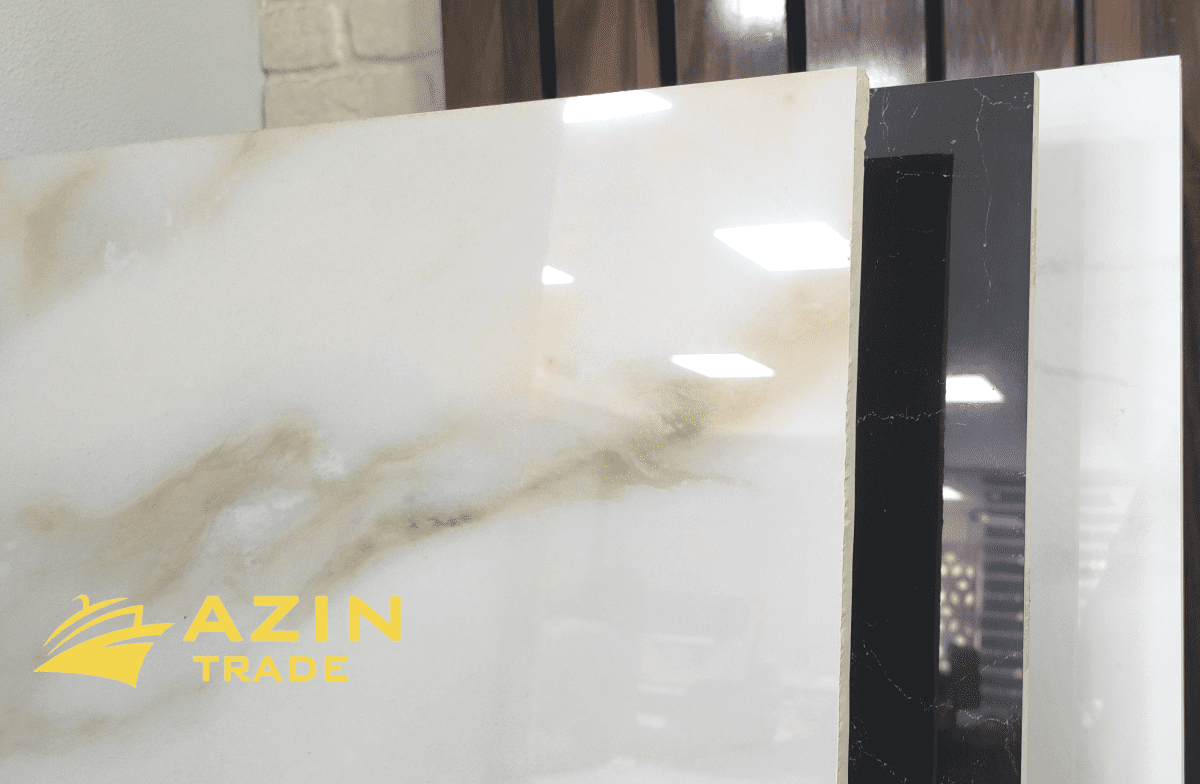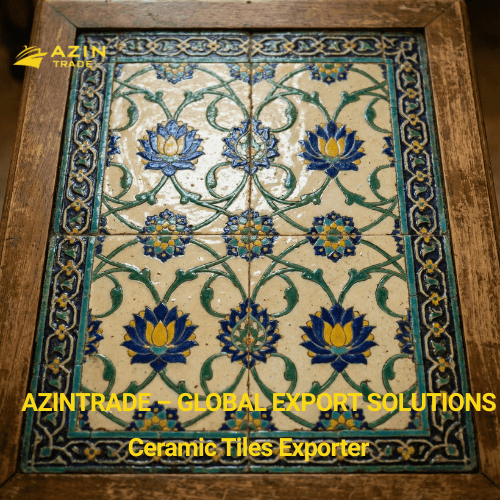Iranian Tiles: A Fusion of Tradition and Modern Innovation
Iran has long held a distinguished place in the world of ceramics, with its tiles representing a mesmerizing mix of art, culture, and architectural function. The roots of Iran’s tile craftsmanship go back centuries, to an era when artisans crafted unique, hand-painted tiles for mosques, palaces, and homes, all with great attention to detail and cultural symbolism. These traditional tiles, often adorned with elaborate floral, geometric, and arabesque patterns, were once a defining feature of Iranian architecture, renowned for their depth, color, and beauty.
In recent years, the Iranian tile industry has taken significant strides in marrying its age-old artistry with modern design sensibilities. As global tastes evolve, so does the demand for tiles that offer both traditional elegance and contemporary style. This evolution has opened up new opportunities for Iran's tile industry, both domestically and internationally, as manufacturers cater to a broader audience eager to incorporate a blend of traditional and modern designs into their spaces.
The Historical Legacy of Iranian Tile Making
The art of tile-making in Iran is deeply rooted in Persian culture, with evidence of ceramic craftsmanship dating back over 5,000 years. Early Persian tiles were often used to depict religious themes and convey stories through intricate designs. During the Safavid era, this art form saw significant growth, leading to the creation of grand mosques and palaces decorated with multi-colored tiles featuring breathtaking motifs. The aesthetic appeal of Iranian tiles lies in their diverse designs—floral patterns, curving arabesques, and symmetrical geometric shapes that reflect the elegance and complexity of Persian art.
What makes Iranian tiles unique is not just their designs, but also the techniques used in their creation. Traditional artisans employed methods such as cuerda seca and mosaic faience, which allowed them to create tiles with vivid colors and detailed patterns. These techniques, although time-consuming, produced tiles that were both durable and beautiful, making them ideal for various architectural applications. Even today, these methods are revered and kept alive by Iranian artisans, serving as a source of inspiration for modern tile makers.
The Shift Towards Modern Design Trends
While the Iranian tile industry remains deeply respectful of its heritage, it has also embraced contemporary design trends to keep up with global demands. Today’s consumers seek tiles that not only serve a functional purpose but also complement a variety of interior and exterior styles, from minimalist and industrial to rustic and traditional. As a result, Iranian manufacturers have expanded their product lines to include tiles with cleaner lines, neutral colors, and understated elegance—features that appeal to modern tastes.
Among the most popular modern tile trends are tiles with sleek, minimalist designs, which offer a subtle sophistication without overwhelming a space. These tiles are often used in kitchens, bathrooms, and living areas where simplicity and elegance are desired. On the other end of the spectrum, bold geometric tiles with sharp lines and contrasting colors are also in demand, especially in commercial spaces like hotels, restaurants, and offices, where they can add a contemporary flair and make a lasting impression.
This fusion of traditional patterns with modern aesthetics has become a signature style for many Iranian tile producers. By incorporating both classic and contemporary elements, they are able to create tiles that resonate with a wide array of consumers, both locally and internationally.
Iran’s Tile Industry in the Global Market
Iranian tiles are not only highly regarded within the country; they have also gained popularity in international markets. The durability, design variety, and artistic value of Iranian tiles make them a sought-after choice for architects, interior designers, and homeowners worldwide. Iranian tiles are now being exported to a wide range of countries, including those in the Middle East, Europe, and Asia, where there is a high demand for materials that combine quality and aesthetic appeal.
This expansion into the global market has been facilitated by advancements in technology and production methods, allowing manufacturers to produce tiles in larger quantities while maintaining quality. With the help of modern machinery, Iranian tile companies can now produce tiles that meet international standards, ensuring they remain competitive in a global market. Furthermore, increased investment in infrastructure and production facilities has allowed Iranian tile manufacturers to scale their operations and respond to growing international demand.

The Role of Digital Innovation in Tile Design
Digital technology has played a transformative role in the Iranian tile industry, enabling manufacturers to create intricate designs with a precision that was previously unattainable. Digital printing technology, for example, allows for high-definition patterns to be applied to tiles, opening up new possibilities for both traditional and contemporary designs. This technology has empowered Iranian manufacturers to recreate classic patterns with stunning accuracy, as well as experiment with new designs that push the boundaries of tile artistry.
Additionally, digital technology has improved the efficiency of tile production. Tiles can now be produced in a wider range of sizes, textures, and finishes, giving consumers more options to choose from. Digital tools have also made it easier to customize tiles to meet the specific needs of clients, whether for a residential project or a large-scale commercial development. This flexibility has allowed Iranian tile makers to appeal to a broader market, as they can offer unique designs tailored to different tastes and requirements.
Sustainability in Tile Production
As sustainability becomes a priority for industries worldwide, Iran’s tile industry is also adapting to this global trend. Iranian tile manufacturers are increasingly adopting eco-friendly practices, such as using recyclable materials and reducing energy consumption in the production process. Sustainable tile options, made from natural materials like clay, sand, and other locally sourced ingredients, are gaining popularity among environmentally conscious consumers. These eco-friendly tiles not only reduce the environmental impact of construction projects but also offer natural beauty and durability.
Some manufacturers are even experimenting with green technology, such as solar-powered kilns and energy-efficient machinery, to minimize the environmental footprint of their production processes. By embracing these practices, Iran’s tile industry is setting an example for responsible production, aligning itself with international standards and the growing global demand for sustainable building materials.
The Impact of Iran’s Tile Industry on Local Communities
The growth of Iran’s tile industry has had a positive impact on local communities, particularly in regions with a strong tradition of ceramic craftsmanship. Tile production provides employment opportunities for thousands of Iranians, from skilled artisans to factory workers. This industry has helped preserve traditional tile-making techniques, passing down knowledge from one generation to the next and ensuring that Iran’s cultural heritage continues to thrive.
Moreover, as Iranian tiles gain popularity in international markets, local communities benefit from the increased revenue generated by exports. This economic boost contributes to the development of these communities, supporting schools, healthcare facilities, and infrastructure projects that improve the quality of life for residents. The success of Iran’s tile industry is thus not only a testament to the country’s rich cultural heritage but also a valuable contributor to its socio-economic development.
Azintrade’s Role in the Iranian Tile Market
One notable player in Iran’s tile industry is Azintrade, a company known for its high-quality tiles and commitment to both tradition and innovation. Azintrade has successfully tapped into the potential of combining traditional craftsmanship with modern technology, producing tiles that meet the aesthetic and functional needs of contemporary consumers. Through its dedication to quality and its forward-looking approach, Azintrade has earned a reputation as a trusted supplier in both domestic and international markets.
By maintaining strong relationships with clients and focusing on customer satisfaction, Azintrade has positioned itself as a leader in Iran’s tile industry. The company’s portfolio includes a wide range of tile designs, from traditional patterns to modern minimalist styles, offering something for every taste and application. With a commitment to sustainability and quality, Azintrade is helping to elevate Iran’s tile industry on the global stage, showcasing the country’s potential in the world of architectural design and construction materials.
Conclusion: A Future Built on Tradition and Innovation
As Iran’s tile industry continues to evolve, it stands as a remarkable example of how tradition and innovation can coexist to create products that are both functional and artistically valuable. With a heritage rooted in centuries of craftsmanship, Iranian tile makers have successfully adapted to modern trends, positioning themselves as global players in the construction and design industry. From intricate mosaics to sleek, modern patterns, Iranian tiles offer a unique blend of cultural heritage and contemporary appeal, making them an enduring choice for architects, designers, and homeowners around the world.
Through the dedication of companies like Azintrade and the industry’s embrace of sustainable practices and digital technology, Iran’s tile industry is well-prepared for the future. As more consumers seek materials that combine beauty, durability, and cultural significance, Iranian tiles will likely continue to be a favorite choice for years to come.




